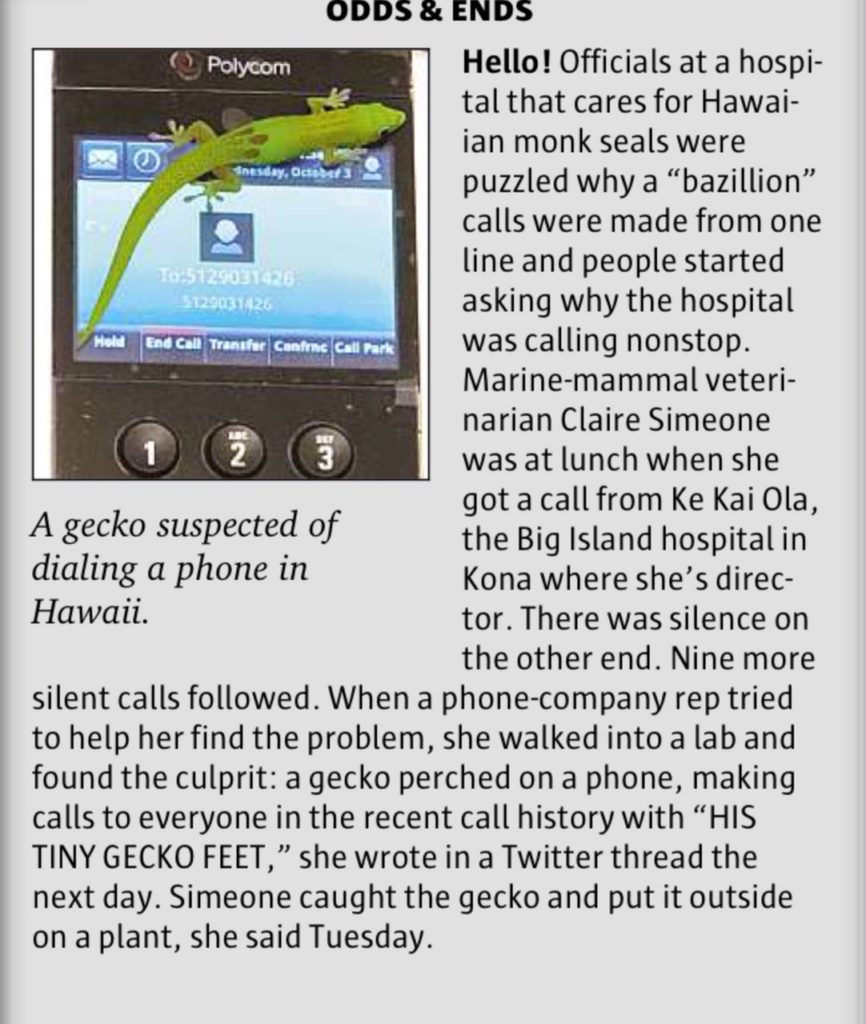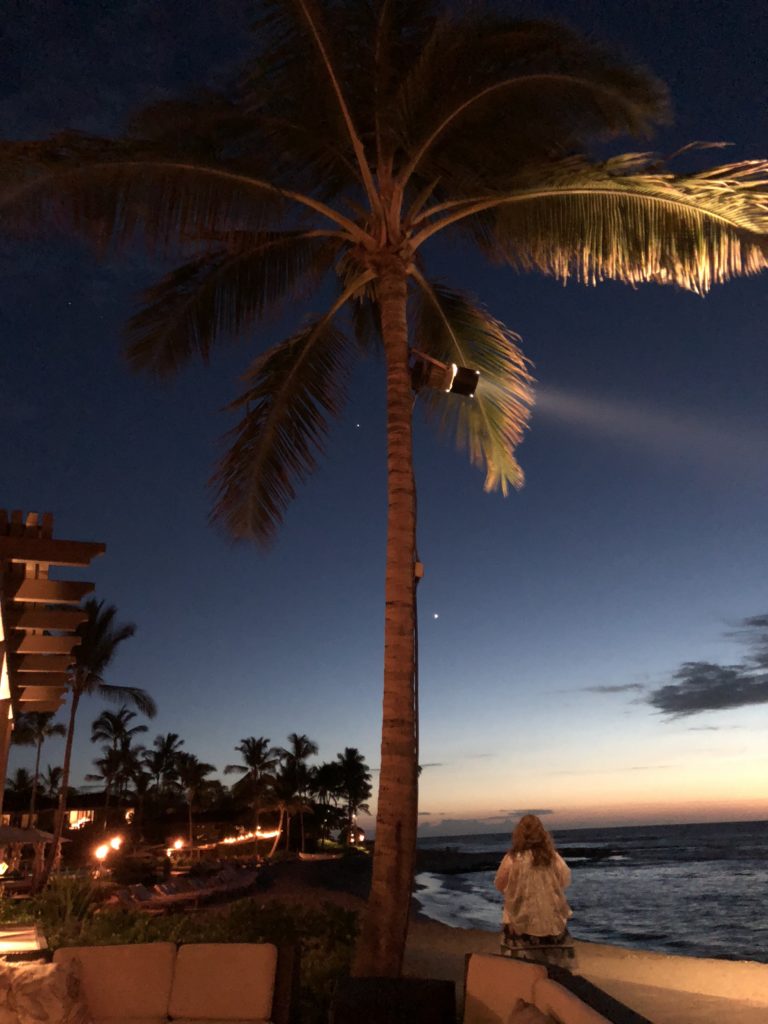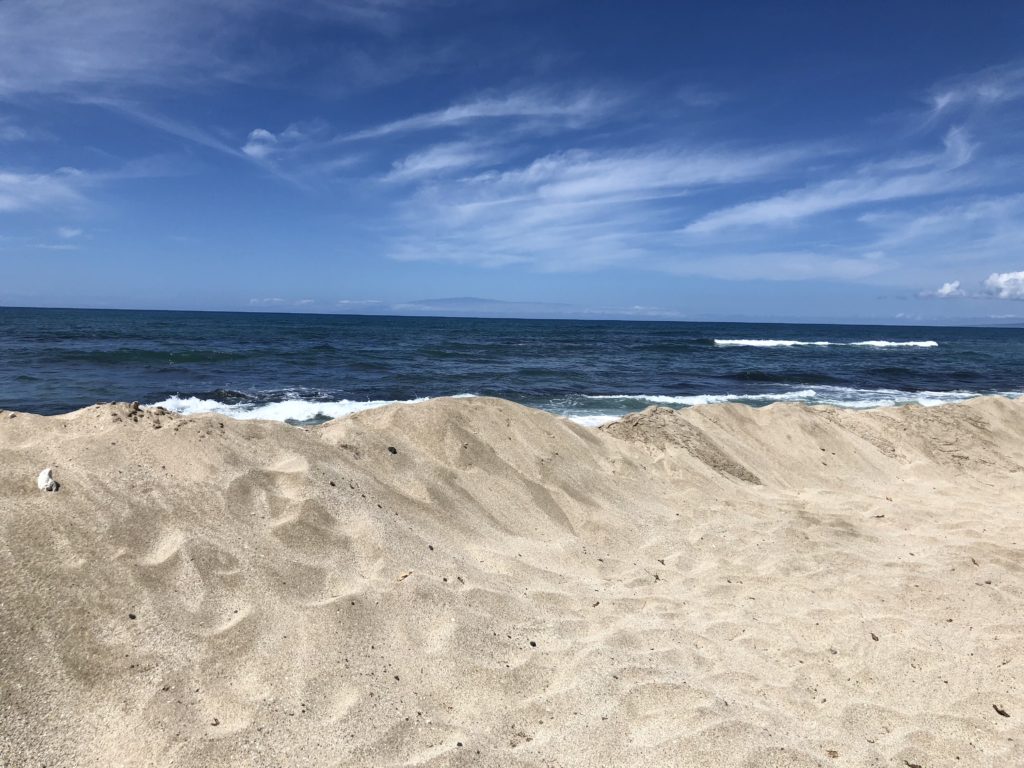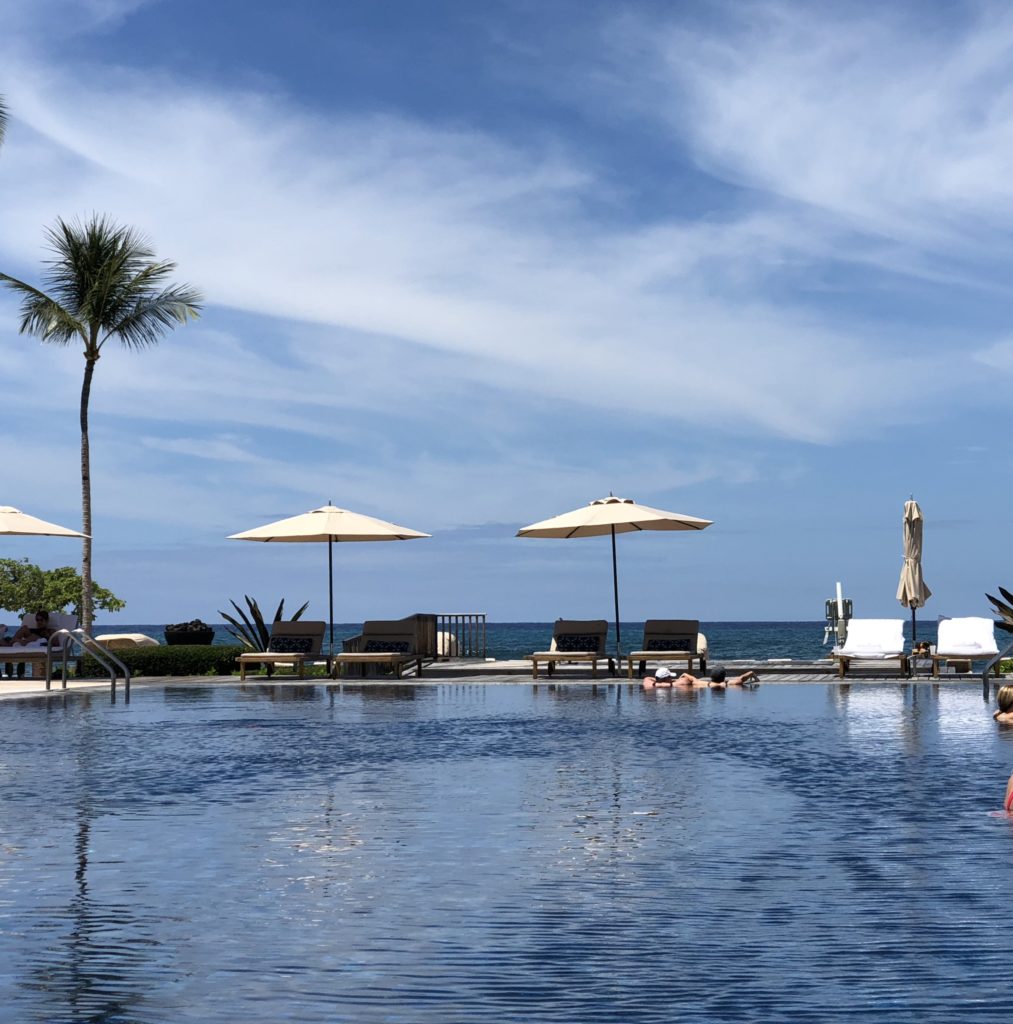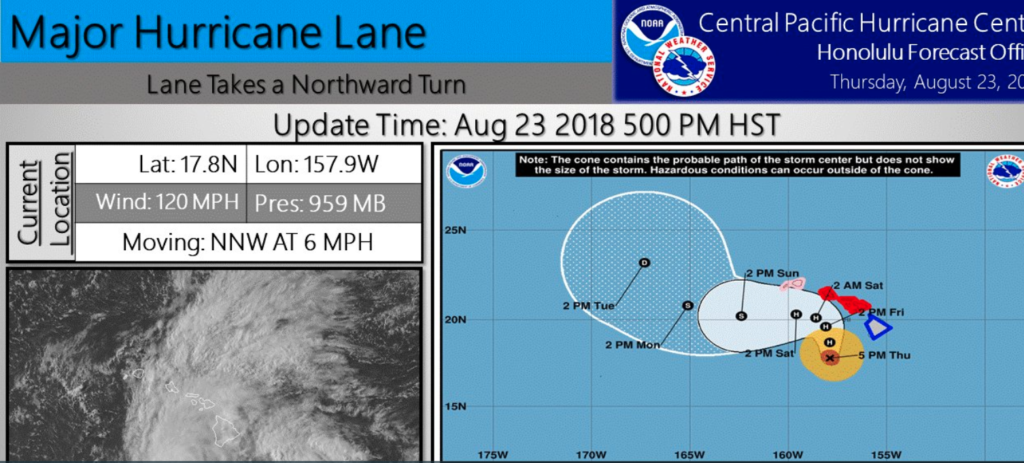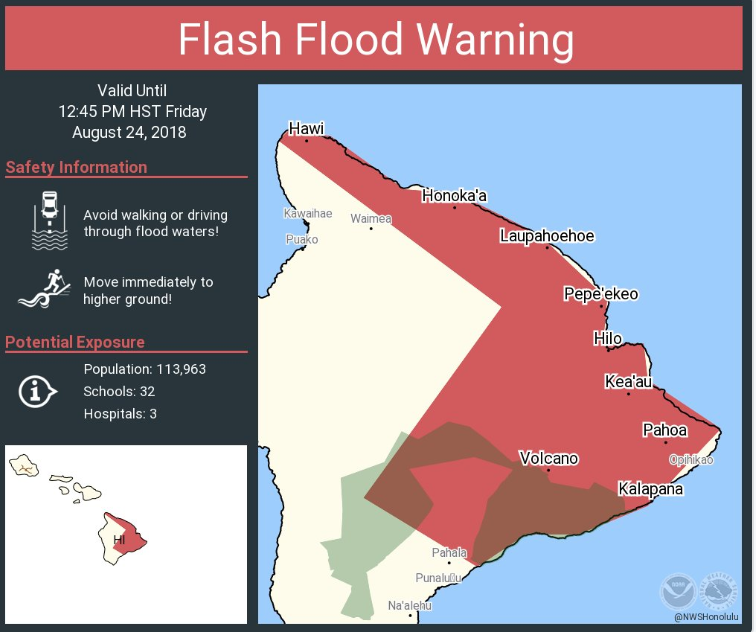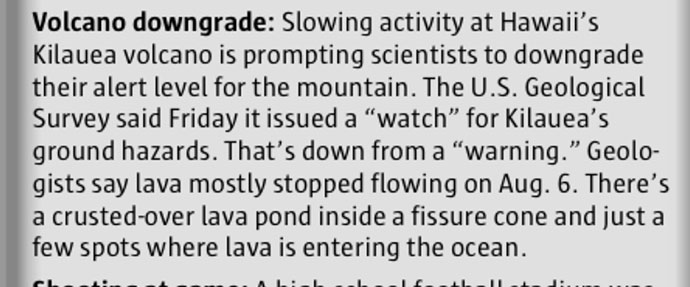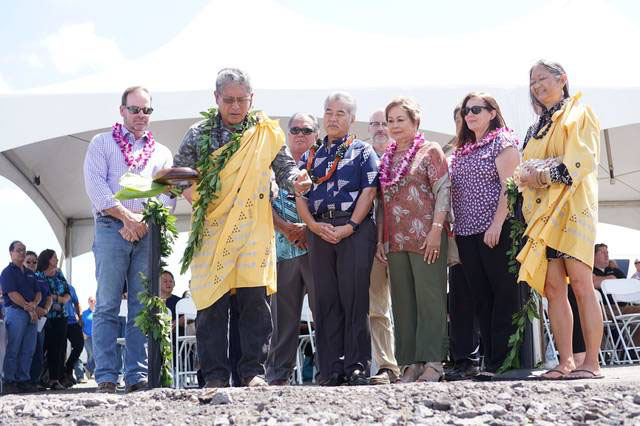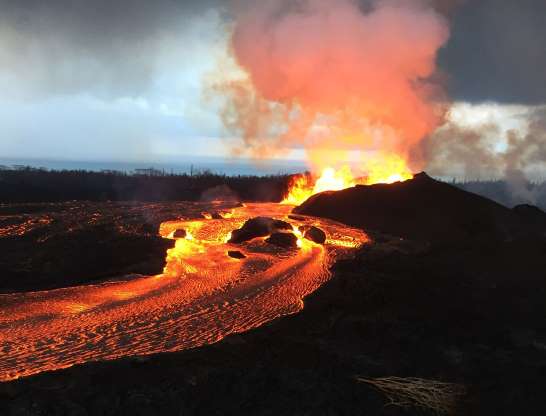
|
By TOM CALLIS Hawaii Tribune-Herald | Saturday, October 6, 2018, 12:05 a.m. 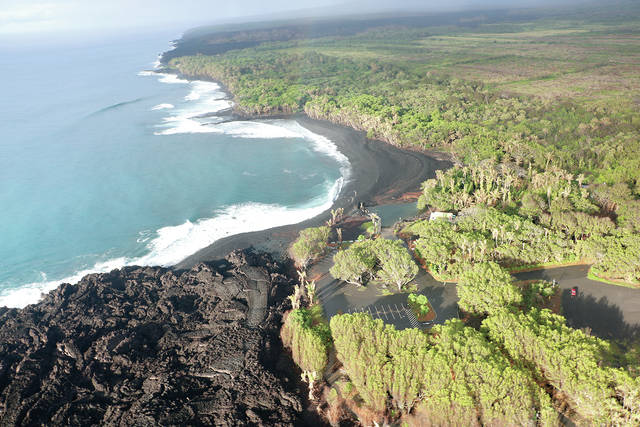 A large black sand beach remains at Pohoiki. The sand continues to block access to the boat ramp, which is just to the right of the center of the photo. The thick fissure 8 lava flows can be seen in the lower left portion of the image. (U.S. GEOLOGICAL SURVEY/Courtesy photo) The Hawaiian Volcano Observatory reduced Kilauea’s alert level Friday as the volcano remains relatively quiet following months of devastating lava flows on the lower East Rift Zone and dozens of caldera collapses at the summit. The change from a watch to an advisory occurred after the passing of 30 days without seeing lava on the surface, along with low rates of earthquakes, ground deformation and only minor gas emissions. There have been no active lava flows since August, though lava was seen inside fissure 8 in Leilani Estates as recently as Sept. 5. According to HVO, resumption of the eruption in lower Puna or summit collapses is “unlikely in the near-term.”
Tina Neal, HVO scientist-in-charge, defined that time scale as weeks or months; she noted they can’t be “super specific” about it. That doesn’t mean there’s no sign of activity. Neal said there are signs of inflation, which indicate buildup of magma, on the rift zone between Pu‘u ‘O‘o and Highway 130. She said it’s not “anything we are very concerned about.” “It’s the most movement, the most inflation we are seeing anywhere on the volcano right now,” Neal said. “It doesn’t look like magma is very shallow. The rate of refilling is not so great that we think it means something is imminent. “If the rate would suddenly pick up or we started seeing earthquakes there, it would be more of a concern.”
One thing is clear: Kilauea remains active and will continue to be monitored closely. Neal said history shows that eruptions rarely resume at the same location if a pause exceeds 30 days. Outliers include a 48-day pause in 1986 at Pu‘u ‘O‘o and a 3.5-month pause during the Mauna Ulu eruption. HVO noted in a volcanic activity notice that this is the first time since 1986 that there has been no surface activity for more than 30 days. “In the past 200 years, the volcano has experienced periods of quiet, ranging from months to years with no eruptive activity,” the agency said. “However, Kilauea is one of the most active volcanoes in the world, and additional eruptions will occur.” The eruption that began May 3 destroyed more than 700 homes and covered major roads. Mayor Harry Kim said Tuesday that lava rock won’t be cleared from Highway 137 until the volcano has been quiet for six months, since the rock could still be hot underneath. But an emergency access road into Pohoiki will be constructed within about two months. In that case, lava rock won’t be cleared, though it would be graded. HVO lost some of its monitoring equipment because of a brush fire caused by lava flows in the vicinity of Puna Geothermal Venture. Neal said crews will see what can be salvaged or replaced next week. Placards are still needed to enter Leilani Estates, the epicenter of the eruption. Starting Monday, placards will be available from Hawaii County Council Member Eileen O’Hara’s office at 15-2879 Pahoa Village Road. Hours are 9 a.m.-3 p.m. Mondays and Wednesdays.
Email Tom Callis at tcallis@hawaiitribune-herald.com. 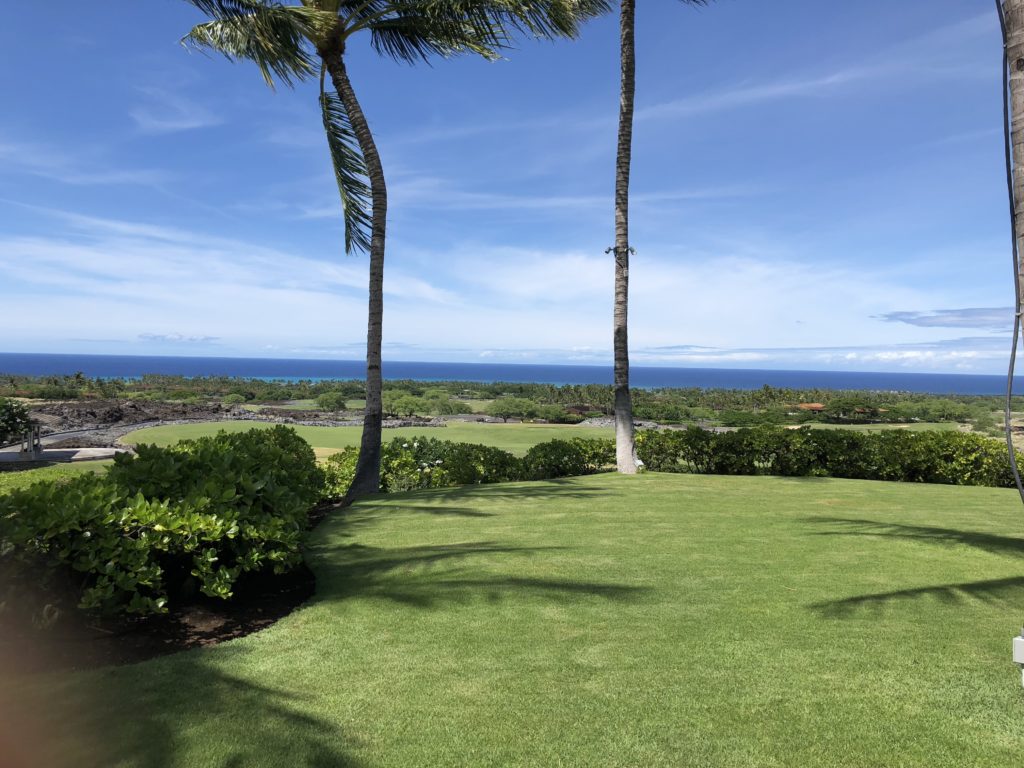 It was another beautifully clear day up at the Ke ‘Olu dining room at Lunch Time
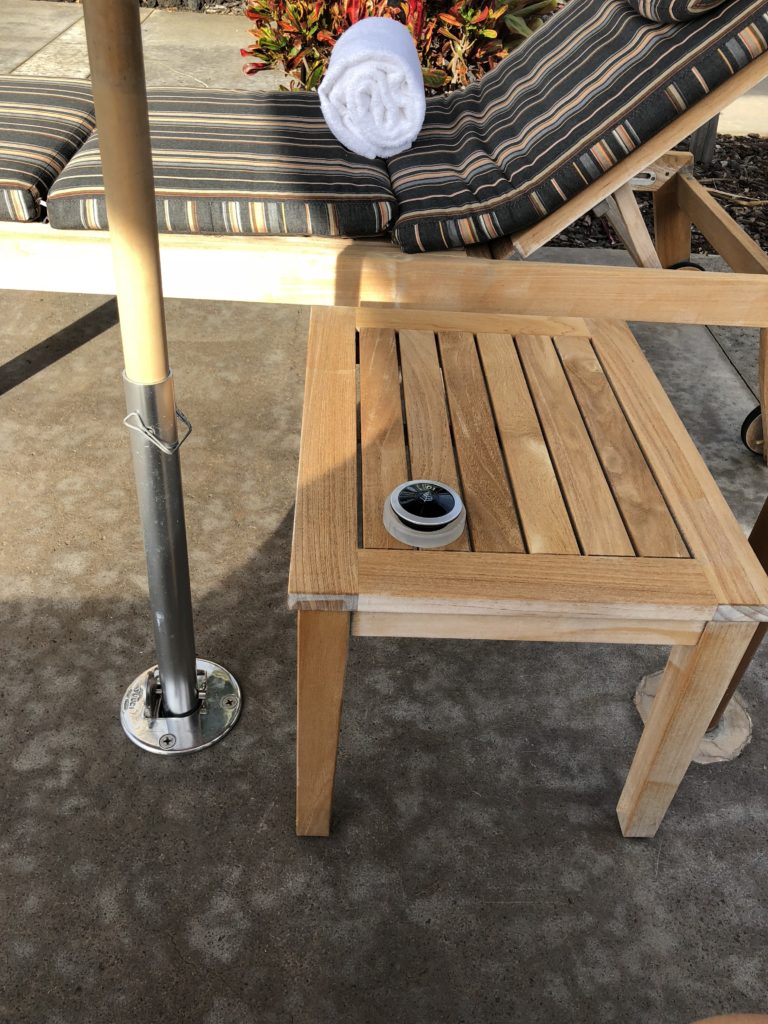 At the Ke ‘Olu pool the call buttons are out on the side tables ready to buzz someone for an order or help. 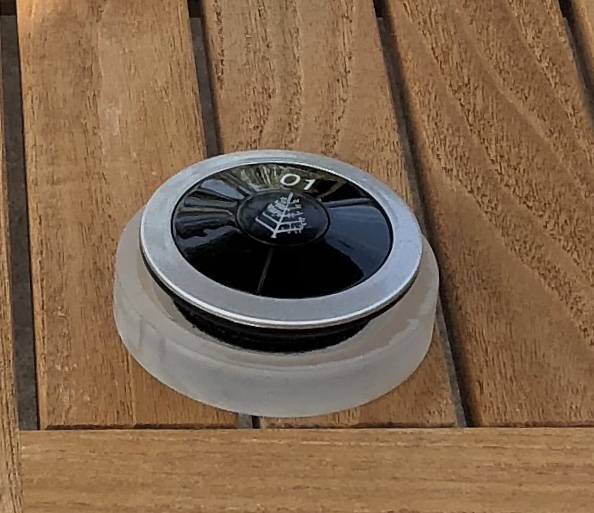 Buttons are numbered so staff know exactly where to go.
 Members John and Martha Mouer with Ken and Pennie Meany enjoying Sintra, Portugal  Ray Lager, Marti diBenedetti and Robert Whitfield at the Dorchester Hotel in London. Robert was the Hualalai’s Four Season’s General Manager until he moved back to London to be the GM of the Dorchester. In LA Times September 27, 2018 by Jay Jones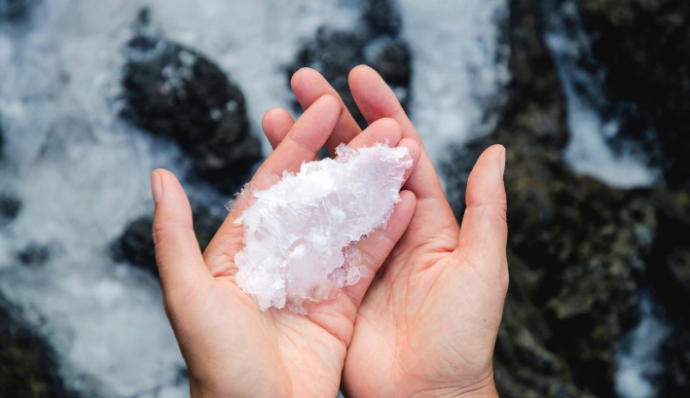 Sea salt comes in several varieties. It is flaky compared to the typical crystals found in table salt. (Andrew Richard Hara) Surrounded by salt water, visitors to the Island of Hawaii can now harvest some of that salt in the same way natives of centuries past did.The “Salt Harvesting Experience” at Four Seasons Resort Hualalai is the newest of the hotel’s “Only at Hualalai” activities.The resort is located along the Island of Hawaii’s Kona coast.Guests take a short hike along the beach to a flat where the salt gathers in “pens” carved in lava rock. There, they use spoons to collect salt in fabric bags.With culinary uses in mind, participants return to the hotel for a cooking class during which a member of the restaurant team demonstrates how flaky sea salt is dried and then used in the preparation of various dishes.The “Salt Harvesting Experience” costs $450 per person.“Our Hawaiian ancestors lived off of Hawaii’s bountiful resources and in turn respected and honored our land and ocean,” said Earl Regidor, the resort’s cultural center manager. “The natural salt the ocean provided was a cornerstone of Hawaiian living — used for food preservation, cooking, medicine and more.”Mahalo to Jack LutskyAmeriprise Financial Services celebrated in a parking lot.
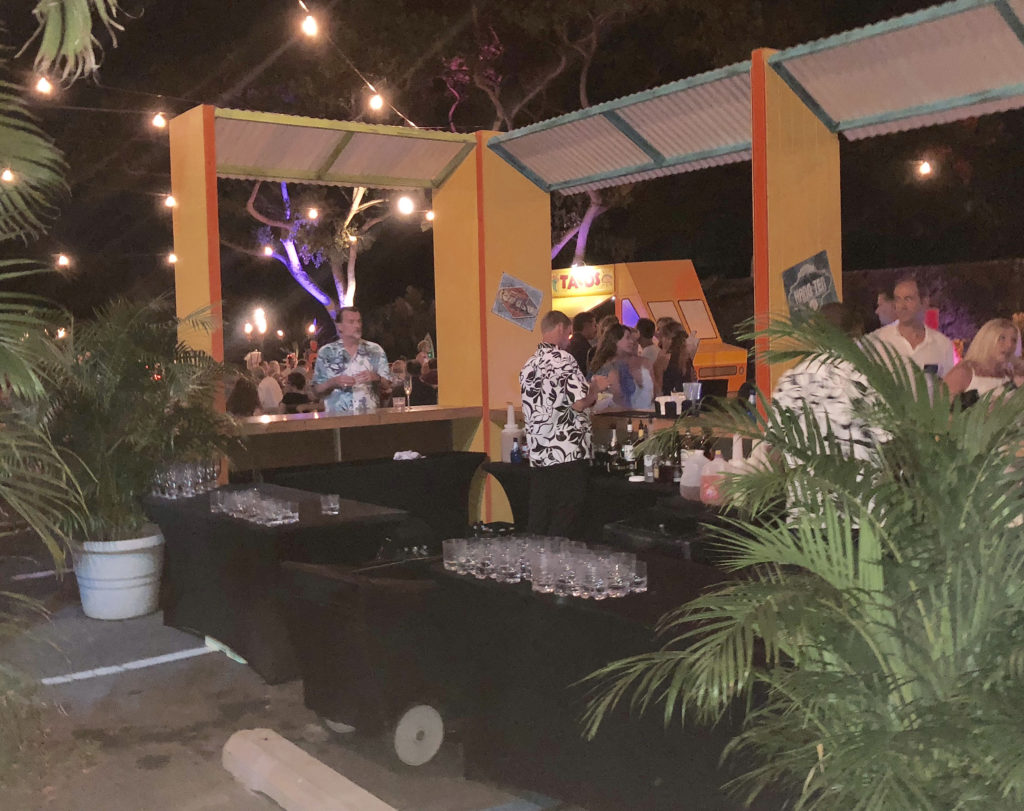 Fake Food Trucks set up in the parking lot by the Concierge Office 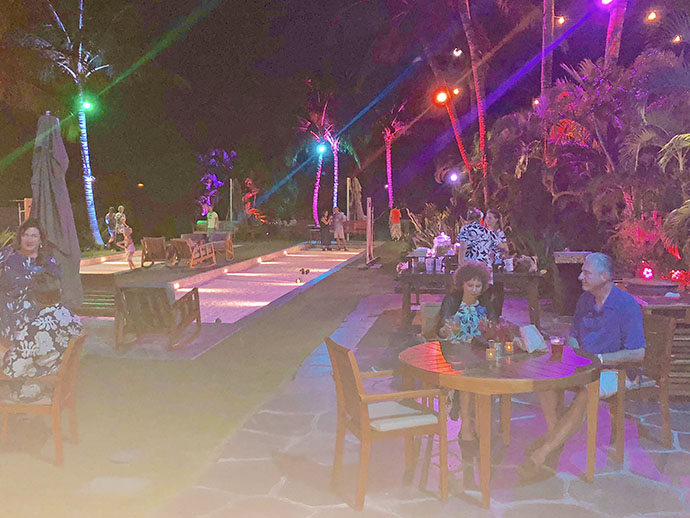 The party continued on the Bocce Ball Court 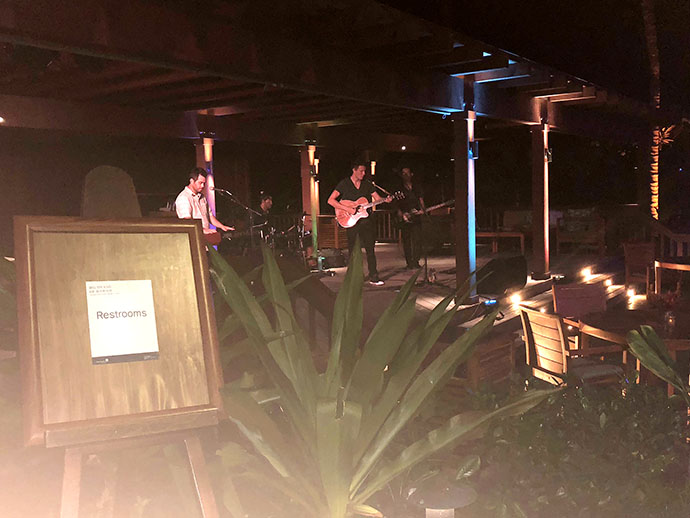 The bandstand was the Coffee Company’s lanai. 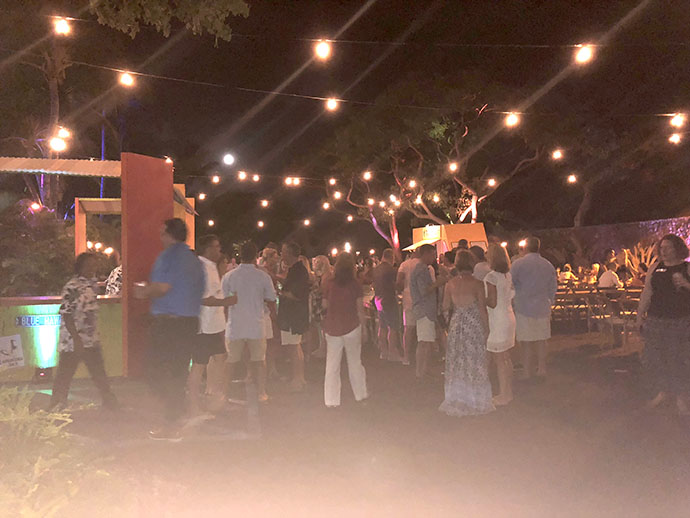 Lights glittered through out the parking lot.  Mike Sack, Marti diBenedetti, John Saul and Connie McHugh met for a quick lunch in SF. Hualalai members received this email today. For many members it is an important change to the definition of family. We felt it important replicate the message here to make sure everyone got the information.
‘Thank you to Regina Stuard http://www.westhawaiitoday.com/2018/08/31/hawaii-news/an-absence-of-lava/
 No lava is seen in fissure 8 in Leilani Estates in this photo taken Monday. (USGS/Courtesy photo) HILO — Lava was no longer oozing into the ocean or sitting inside fissure 8 during an overflight Wednesday morning, according to the Hawaiian Volcano Observatory. That appears to mark the first time that lava was not seen anywhere since the eruption on Kilauea’s lower East Rift Zone subsided almost four weeks ago. It also could mean that the boat ramp at Pohoiki, which is blocked by a new black sand beach, will avoid being covered by lava. Molten rock had inundated parts of Isaac Hale Beach Park at the same location. It remains unclear, however, whether the eruption is over or just taking a break, said Janet Babb, an HVO spokeswoman and geologist. She also noted that there have been days during the past few weeks when no incandescence was visible within the fissure, so the absence of a lava pond Wednesday doesn’t mean that lava won’t be seen there again. As for how long conditions have to remain calm before the eruption is considered over, Babb said that remains a matter of discussion. She noted the Mauna Ulu eruption took a break for three months before restarting. “It’s probably more difficult to say when it’s over than to forecast when one might start,” Babb said. As for the sand blocking the boat ramp, Dan Dennison, a spokesman for the state Department of Land and Natural Resources, said in an email the department has not decided what to do about that. “Until staff can get in and take a close look, we don’t have any idea about its future,” he said, referring to the state-owned ramp. “Whatever may be decided will be done in close consultation with Hawaii County due to road access issues and the reopening of Issac Hale Beach Park.” The lava flow field is crusted over but remains hot, and rain can produce steam and whiteout conditions, according to HVO. Hurricane Lane also damaged some of HVO’s field sensors. Babb said those are coming back online. She noted spikes in ground deformation data seen on HVO’s website are the result of the sensors becoming “settled” after being repaired. Babb said the website will switch to data from a different tilt meter that wasn’t lost, and noted that changes in the deformation data on that meter might reflect impacts from heavy rainfall. She said there’s been no actual deformation associated with magma at the summit or on the rift zone. Deformation, in which the ground moves up or down, could be a sign that eruption activity is going to resume. The latest Kilauea eruption has destroyed more than 700 homes from Leilani Estates to Kapoho since starting May 3. The Kilauea Disaster Recovery Center will be closed Labor Day weekend, according to the Federal Emergency Management Agency. It will reopen at 8 a.m. Tuesday at the Pahoa Neighborhood Facility, 15-3022 Kauhale St. Evacuees can also register online at disasterassistance.gov and by calling 621-3362 or 462-7585. More than $30 million in low-interest loans have been approved for people affected by the disaster through the U.S. Small Business Administration. That includes about $22.5 million for homeowners and $8 million for businesses. That’s on top of individual assistance grants approved through FEMA, which totaled $7,188,518 as of Aug. 15. The deadline to register with either agency is Sept. 12. Email Tom Callis at tcallis@hawaiitribune-herald.com. Thanks to Eve Bernstein
Thanks to Paul Locklin
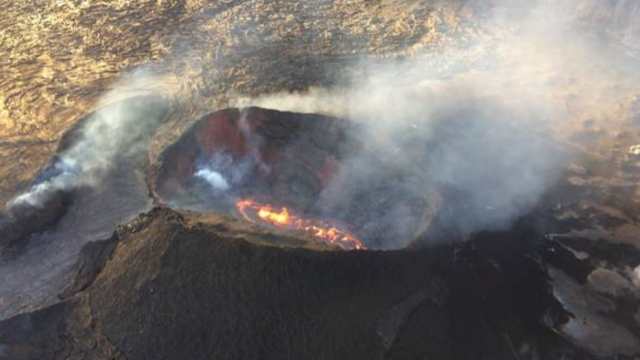 Fissure has quieted down. After speaking a number of folks on the Kona Coast, the vog has improved immensely, skies are blue and air is clearer.
Thanks to Alex Gersznowicz
KAILUA-KONA — As local officials celebrated the dedication of the newly widened stretch of Queen Kaahumanu Highway, the sound of horns from passing cars punctuated the speeches and remarks, notes of thanks — or at least, relief — for the completion of a project years in the making. Three years after breaking ground and more than 10 years since the state first awarded a bid for the project, the highway now spans four lanes of north- and southbound traffic for a little more than 5 miles between Kealakehe Parkway and Keahole Airport Road. “Even though we blessed this three years ago, we prayed every day that this would be completed,” said kahu Daniel Akaka Jr., who provided the blessing Thursday and at the 2015 groundbreaking. “So this is a happy day for all of us, this community and for the Island of Hawaii.” Thursday’s ceremony officially marked the $121 million project as “substantially complete,” with some work, such as landscaping and signage installation, still remaining. Motorists driving through the area will likely notice the use of ’a’a in the median. Donald Smith, Hawaii District engineer with the state Department of Transportation Highways Division, said the use of ’a’a isn’t just for aesthetics, it’s also low-maintenance and discourages motorists from attempting to cut across the median. And for those who have worked to push the widening project forward, Thursday’s dedication was cause for celebration. “The area north of Kona, the area that this portion of the Queen Kaahumanu Highway services, is a great example of the best that Hawaii state and Hawaii Island has to offer,” said Gov. David Ige in remarks to the crowd. “Scenic views, a connection to the history of the people of the first nation of Hawaii, our second international air point-of-entry at Ellison Onizuka Kona International Airport and really an example of technical, environmental and cultural innovations coming together to make a difference for our community.” Ige added that ensuring continued support of state infrastructure in the region “will continue to be one of my priorities.” In addition to widening the highway from two to four lanes throughout the project area, Ed Brown, Hawaii vice president of operations for Goodfellow Bros. Inc., noted that the effort also resulted in six new signalized intersections, as well as 4.5 miles of new water lines. It also resulted in a new sewer system to move water from regional developments to the Kealakehe Wastewater Treatment Plant and an R-1 line to bring back treated water. “This team, our work family, has taken on lots of obstacles and has endured tough hurdles,” said Brown. “Regardless of that, we always had the goal to build the best, safest, long-lasting and highest-quality road for the community.” Brown said more than 210,000 man-hours went into the project, noting that all workers, including construction crews, come from Hawaii Island. “What was created is a state-of-the-art travel way that is not only to meet the demands of today but is built for the future,” he said. Local lawmakers, too, celebrated the milestone, including state Rep. Nicole Lowen, who told the crowd that the project was likely the No. 1 topic of phone calls to her office from constituents over the last few years. “So it’s just really exciting that all the lanes are open,” she said. “Traffic is moving smoothly.” It was also cause for celebration for state Sen. Lorraine Inouye, who was Hawaii County’s mayor in 1991 when then-Gov. John D. Waihee III and then-DOT director Edward Y. Hirata came to her with the original plans to widen Queen Kaahumanu Highway. “You would not believe how things have changed from the first plan that I saw,” she said, sharing that the original proposal included on-ramps and off-ramps. The first phase of the widening project would eventually break ground in September 2005 during the Lingle Administration and be dedicated in spring 2009. Now, as senator, Inouye chairs the Senate Committee on Transportation and Energy. “It’s just to show you how long it takes to get a project of this magnitude,” said Inouye. Thanks to Eve Bernstein, Cindy Muscatel, Susan Mendelson and Paul Krug HILO — Hawaiian Volcano Observatory scientists confirmed Sunday that rates of seismicity and summit deformation have decreased, as has lava output from fissure 8. HVO geophysicist Jim Kauahikaua said the number of earthquakes have dropped considerably since before the the most recent summit collapse event, which occurred shortly before noon on Thursday. “Typically, it was between 25 and 35 earthquakes per hour in the summit area, and now we’re down to under five, and usually under two per hour,” Kauahikaua said. He described those earthquakes as “very small.” Tina Neal, HVO’s scientist-in-charge, said “it’s too early to tell” if the downturn in seismic activity and lava output means an end is in sight to the current eruption along Kilauea’s lower East Rift Zone, which started on May 3. She also noted a significant increase in gas emissions from Pu‘u ‘O‘o vent on Friday. “It could be weeks or months before we feel comfortable calling the eruption and the summit collapse over,” Neal said. “… It’s not uncommon for eruptions to wax and wane. So this could turn around at any point and resume. We’ll just have to wait and see. “We’re trying to compare what is going on now with the 1955 and ’60 eruptions. In 1955, there were two long pauses in that eruption. It wasn’t a perfect analogy to this event; there are some differences. In 1955, there were breaks of five and 16 days where it was quiet, and then it broke out again. “I’ve had a few calls as far as people wondering if it’s over, and I’ve told them no,” added county Civil Defense Administrator Talmadge Magno. “Especially people in Leilani, because it’s quiet near the fissure and they’re wondering what’s going on.” Kauahikaua said fissure 8, situated in Leilani Estates subdivision, is “still erupting” but the lava pond within the crater is “partially crusted over … and then, the spillway itself is crusted over.” “That doesn’t mean there’s no flow out along the channel,” he explained. “… There are still small flows active as far down as Kapoho Crater, but they haven’t gone very far and they’re not very active.” The ocean entry remained active at the site of the former Ahalanui Beach Park on Sunday. It was noted during HVO’s 6 a.m. overflight there were a few sluggish seeps and ooze-outs near Halekamahina and Kapoho Crater. Lava also continued to ooze into the ocean along a broad flow front and laterally toward Pohoiki but was still about 230 feet southeast of the boat ramp. Kauahikaua said despite the decrease in lava being churned out by the fissure “it’s still possible” the boat ramp — which has been within a proverbial stone’s throw of an edge of the flow front for about three weeks — could still fall victim to fissure 8’s molten rock. “It would depend on how much lava is stored in the interior of the flow,” he said. “Lava like this has a tendency, when it comes out, to flow along the coast instead of go straight into the water. And so, what you see there is a lobe of lava that’s following the coast towards Pohoiki. There’s no way to tell right now whether that will continue or whether it will die off.” Noting that today is the first day of instruction for the 2018-19 public school year, Kim said plans are still a go for a bypass road for the damaged section of Highway 11 between the 28- and 32-mile markers in the Volcano village and Hawaii Volcanoes National Park area. “It’s full speed ahead on all the planning mechanisms we’ve got going, including meeting with the governor. … All of that will continue,” he said. “What we’ll do now is re-evaluate when we’re going to start. The plans to expedite this still remains until (scientists) tell me this is over. … The initial plan for completing the temporary emergency highway was two weeks. Hopefully, now, we’ll have a little breathing time to slow down a little bit.” Hawaii Volcanoes National Park remains closed for the time being, as well. According to Neal, despite the reduced intensity of both summit seismicity and lava production, HVO is “trying to reinforce the message that the hazard has not gone away.” “There’s still active lava in the channel; there’s still lava going into the ocean. So we’ve got laze and the attendant hazards from that,” she said. “There’s still (sulfur dioxide) coming out of the fissure 8 vent and the other cracks nearby. So we don’t want people to just completely let down their guard and think it’s safe. They still need to pay attention to Civil Defense closures and that sort of thing. “Likewise, up at the summit, even though things are quiet, we’ve got all these steep rock walls that have developed during the collapse events, so it’s possible that rock falls could occur on their own. It hasn’t become a completely safe environment.” By Chase Thank you to Eve Bernstein
Geologists monitoring the eruption of the Kilauea volcano say it could continue to spout lava for a long time. The volcano has been erupting since early May in the Leilani Estates neighborhood on Hawaii’s big island, forcing evacuations and destroying more than 700 homes. The US Geological Survey’s Hawaii Volcano Observatory said the eruption has covered more than 12 square miles (23 square kilometers) with black lava and has added 700 acres of new land to the island. A report from the Hawaii Volcano Observatory found that this eruption, in what geologists call Kilauea’s lower East Rift Zone, has produced a greater volume of lava than past eruptions in the area. “Given this volume and the sustained withdrawal of magma from the summit reservoir without appreciable deformation in the lower East Rift Zone, it is most likely that the LERZ eruption may continue for months to years,” the report said. Kilauea has been erupting on and off for centuries, according to the US Geological Survey. The most recent eruption has ripped dozens of fissures in the Earth’s surface, allowing lava and dangerous gasses to escape. The most prominent is fissure 8, which is spewing out lava that runs in a channel from Leilani Estates to the ocean. The report said that lava is flowing out of fissure 8 at an estimated rate of 100 cubic meters per second and shows no signs of waning pressure. ‘If the ongoing eruption maintains its current style of activity at a high eruption rate, then it may take months to a year or two to wind down,” it said. “While this seems to be the most likely outcome, a pause in the eruption, followed by additional activity, cannot be ruled out, nor can an abrupt cessation or a transition to steady, longer-lived activity at a lower effusion rate.” The Hawaii Volcano Observatory gave the report to the Hawaii County Civil Defense to help them prepare for possible threats from the eruption. It said that a breach in the current channel could divert the lava in a new direction and put other areas at risk. “The main hazard from the source cone and the channel system is a failure of the cone or channel walls or blockage of the channel where it divides in narrower braids. Either could divert most, if not all, of the lava to a new course depending on where the breach occurs,” the report said. The report focused on threats to areas north of the current lava flow because they have not been evacuated. By David Williams, CNN Thanks to Kathy Styer |

